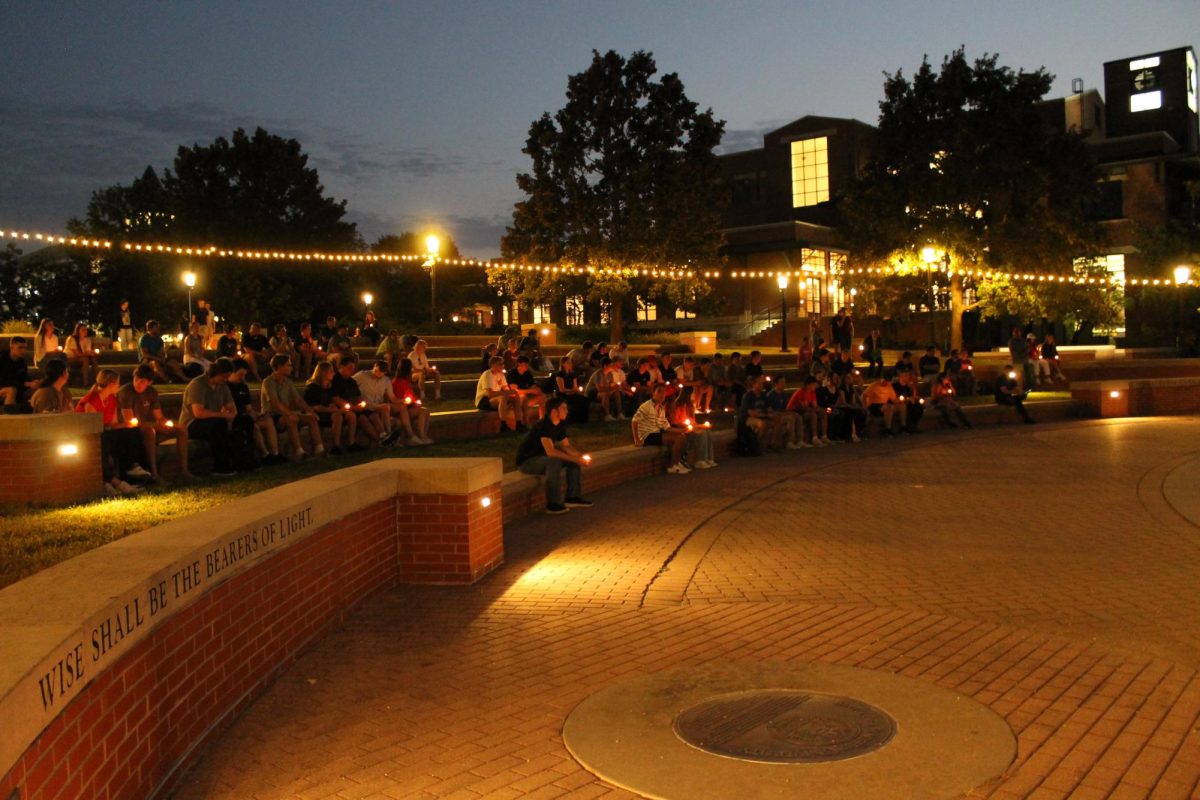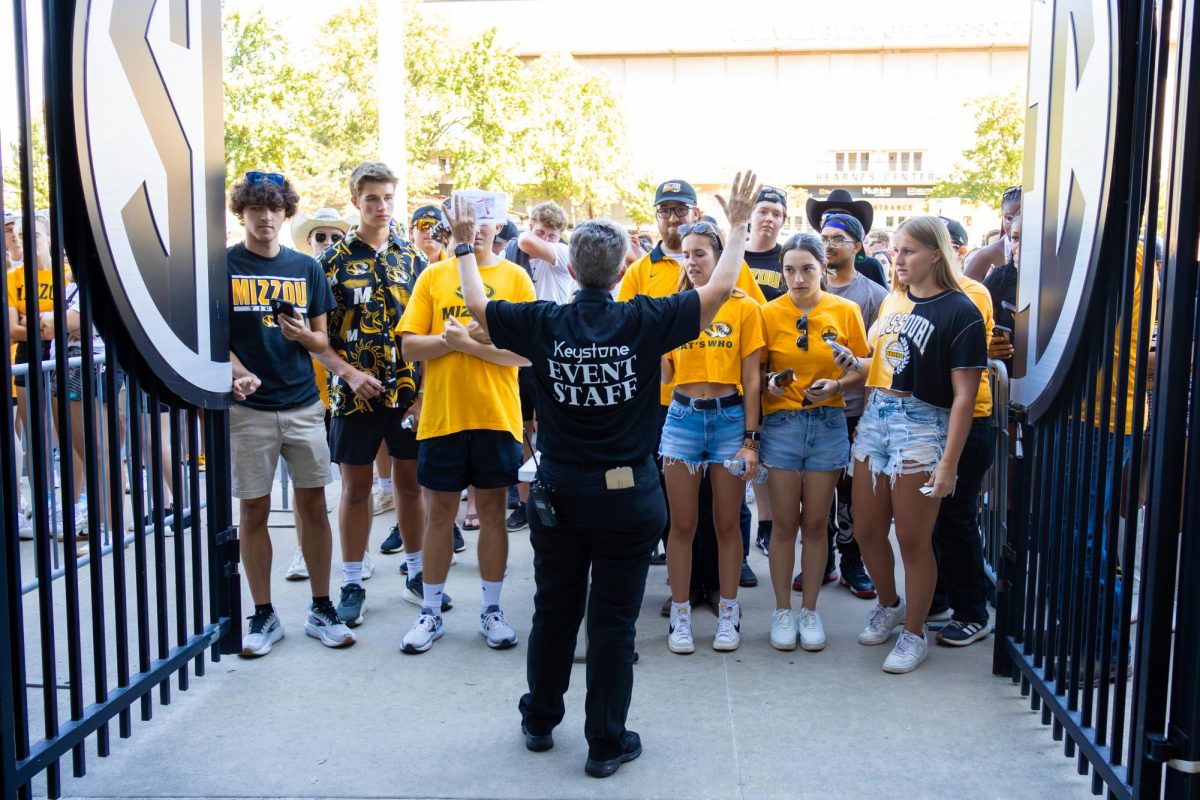Sophomore Rio Chacon stands outside the door, their hand hovering. It is a smaller bathroom — the two-stall kind — but instead of entering, Chacon pauses to listen for a flush, the noise of the sink, chattering, anything to indicate a person is inside. If Chacon hears a noise, they wait. For Chacon, who identifies as transgender and gender fluid, using bathrooms at MU has not been a smooth experience.
“I’ll just kind of stand there for a second to hear if anyone’s in there before I go in,” Chacon said. “I hate doing that, but I just don’t want to be there while someone else’s in there, just because I don’t want to make anyone else uncomfortable.”
Last spring, the the Student Fee Capital Improvement Committee granted $4,000 to the Missouri Students Association to change signs on single-stall bathrooms on campus to make them gender-inclusive.
MSA Senator Sterling Waldman, a sophomore member of the social justice committee, proposed the legislation, which passed unanimously. Waldman, who identifies as queer and transgender, said they saw the need to increase the number of gender-neutral bathrooms on campus based on their own experiences.
MU spokesman Christian Basi said in an email that Campus Facilities and the Department of Residential Life were both involved in the process.
Residence Halls Association President Matt Bourke said signs for single-stall bathrooms and showers in older residence halls that read “Women” and “Men” have now been changed to read “Toilet” or “Toilet and Shower” accordingly. Bourke said $1,000 was used to convert these signs.
Basi said the remaining $3,000 was allocated to change signs in other campus buildings based on an MSA priority list. Despite the availability of these funds, changes have not been made.
“The MU Sign Shop on campus currently only has one person, so the university is a bit behind in work orders,” Basi said in an email. “Work orders for the bathroom signs have been initiated.”
However, Basi did not know when this will be completed.
Senior Finn keeps their head down, avoiding eye contact at all costs. They requested their last name not be used in this article for privacy purposes. With only minutes left to get to class, and not a gender-neutral bathroom around, Finn, who identifies as transgender, has to use the men’s bathroom.
“I put my head down and don’t look at people because then I don’t look like a threat, in my opinion,” Finn said. “I shouldn’t have to fight to use the bathroom. For people to even just look at me funny, like, ‘Uh, you’re in the wrong spot.’ Well, I don’t really have a right one here.”
Finn said they were not aware of the changes MSA had made with the bathroom signs and did not see a significant difference from before. Chacon said they were aware of the changes, but did not pay much attention to them because they mainly use the gender-neutral bathroom near the LGBTQ Resource Center.
Finn said they predominantly use the gender-neutral bathroom near the resource center and also in Middlebush Hall. Waldman said they are comfortable using gender-neutral bathrooms in general, but none of the buildings they have classes in have gender-neutral bathrooms. But if any of them are not near the bathrooms they feel comfortable using, all three said they use gendered bathrooms out of necessity.
“I’ll go into a women’s [bathroom] just because [it’s a] ‘how I was assigned at birth’ kind of thing, just because I can’t get into trouble for doing that,” Chacon said. “It makes me uncomfortable, as someone who is pretty confident of how I identify. So it feels like I’m going against what I am when I go into those restrooms.”
Finn said it is hard to deal with something that seems to have a simple solution when they experience body dysphoria, struggling to come to terms with their body and how they appear every day.
“I have a binder that makes my chest completely flat, but I can’t wear it all day because it makes me sick because it’s really tight,” Finn said. “It is that constant fear of, ‘Am I actually ever going to get beat up in the guy’s bathroom?’ Maybe. ‘Will it be because they can see my boobs?’ Maybe, maybe not.”
Similarly, Waldman said they experience a lot of dysphoria when they are forced to use a gendered bathroom.
Finn said it is frustrating to use gendered bathrooms because outside of campus, they have been yelled at for being in a women’s bathroom. Finn said it is essential that people get educated on this issue.
“You’re afraid of something because you don’t understand,” Finn said. “Understand your fear and realize that holy s—, they’re just trying to pee.”
Chacon said they have used the men’s bathroom in the past, and they see issues with the resources the bathrooms have.
“In men’s restrooms, they don’t have a little trash can thing in their stalls,” Chacon said. “So trans individuals may have to figure that situation out, because some of them still use feminine products, so that’s a whole other thing.”
Chacon said there is also a special need for tampons and similar products in gender-neutral bathrooms because a lot of individuals within the community rely on these bathrooms.
For Chacon, it has been particularly difficult at their job in Kansas City, where they do custodial work in a museum. They said they feel like they have to identify as a woman because they are afraid to be out in professional settings. Chacon said it is hard because in their work clothes they pass as a man, and a lot of their focus is on making other people feel comfortable, even though they are not.
“I enter the women’s restroom just because that’s how I identify there,” Chacon said. “[The employees] expect me to go in there easily, but when I do, it’s uncomfortable because I have to like, make eye contact with people or talk to them, just so they’re not uncomfortable.”
Waldman, Finn and Chacon said they all would be comfortable with the concept of a multiple-stall gender-neutral bathroom, but they do not feel the campus community is ready for it. Waldman said they would probably have received pushback had they proposed such legislation.
“There’s still a lot of stigma around multi-stall gender-neutral bathrooms,” Waldman said. “Which is why they weren’t included in the legislation.”
Finn and Chacon also said they feel some individuals in the transgender community may not be comfortable with the idea of a gender-neutral, multiple-stall bathroom.
“I don’t know if trans individuals would be comfortable with that just letting anyone go in there while they’re in there,” Chacon said. “It’s like another thing with harassment. You just don’t know if homophobic or transphobic people are going into that restroom.”
Finn said that especially with minority groups, such as transgender women of color, there is an increased risk of violence.
“They need to have the privacy and safety they require, to not be harmed in any way even by looks, by nothing,” Finn said.
Waldman, who was new to MU last year, said their high school experience influenced their commitment to this legislation.
“I was pretty involved in high school in making sure there was a space for me and my friends,” Waldman said. “I already had that in mind coming here.”
Waldman said a central part of the discussion was the wording of the signage, which took around three months to decide.
“I think people understood the need for [the legislation]; it was generally supported,” Waldman said. “I think that some people had more issues with certain language things then like the broad concept of needing more gender-neutral bathrooms on campus.”
Basi said that due to budget constraints, they were unable to convert all the signs.
Bourke said the signage on newer buildings was not prioritized because they already include “unisex” bathrooms.
“At least [the bathrooms] say something,” Bourke said. “At least they’re not single-stalled gendered bathrooms. They’re just unisex bathrooms.”
Although efforts were made prior to Waldman’s legislation, Waldman said previous legislation had included language like adding more “unisex” bathrooms, a term they consider outdated.
Waldman said although they were unable to get the old “unisex” signage changed, they made sure that “unisex” was not used in the new legislation.
Finn said there is a big difference between the two terms.
“They’re really tiptoeing around this issue,” Finn said. “They’re not saying gender-neutral; they’re talking about sex, and they’re completely different things.”
Waldman, Finn and Chacon expressed frustration about waiting to use gender-neutral bathrooms with those who could have used a gendered bathroom. Chacon said it is possible that those who are not within the LGBTQ community do not realize the importance of the bathroom, especially the one near the LGBTQ Resource Center.
“I know a lot of people hate that,” Chacon said. “They’re waiting for a restroom where they feel comfortable in, when someone can use a [gendered] restroom.”
Finn said the ideal situation would be to have single-stall gender-neutral bathrooms be explicitly labeled as being gender-neutral.
Waldman said MSA created a map for gender-neutral bathrooms five years ago, but that it is not up-to-date. Additionally, Waldman said students can search “gender-neutral” on the GoMizzou app to find a bathroom. However, Waldman said not all of them are included and the map is outdated.
Chacon said although they are aware of the map, they do not think the way it is set up is helpful. They said the map could be more accurate and include what floor a bathroom is on.
“I feel like they could be more detailed about where these [bathrooms] are located,” Chacon said. “It’s usually like super hidden depending on what building it is.”
Bourke said he was not directly involved in the passing of the resolution but was still able to see the process play out as the representatives were learning from the legislation itself.
“I want to make sure that those students are feeling like their experience becomes better because of the work RHA does,” Bourke said. “If that means you don’t have to be freaking out, worried about what bathroom you’re going to use, then I think RHA has done its job.”
However, Waldman said there is still a lot of work to be done.
“It’s been needed for so long that we’re just kind of like, ‘Okay, this is great, and we need more,’” Waldman said. “It’s almost halfway to basic necessities.”
_Edited by Kyra Haas | [email protected]_







